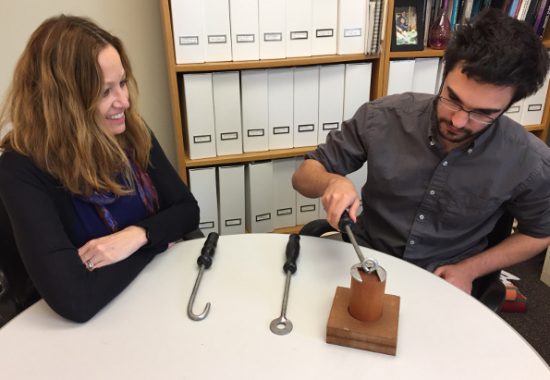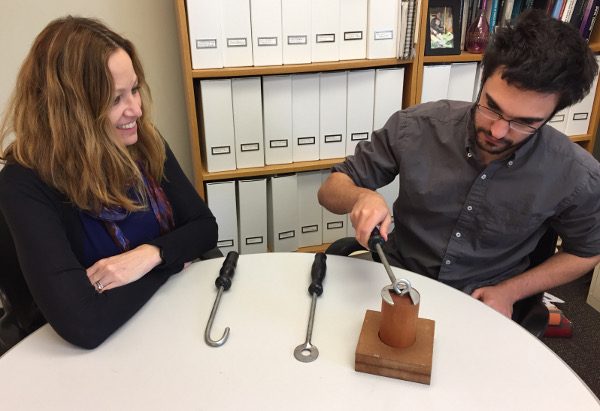Imagine attempting to find an everyday kitchen item—for example, a spatula— in a drawer, and then using the spatula to flip a pancake. What if instead of retrieving the spatula, you picked up and used a nearby fork with a spatula-like action? Such errors, in which objects are mis-used during the course of everyday actions, are experienced by thousands of individuals with a disabling and common disorder known as limb apraxia.
For more than two decades, the Cognition and Action Lab at MRRI, headed by Laurel Buxbaum, PsyD, has been making strides in understanding both the neurological deficits and regions of the brain involved in this disorder, as well as the normal cognitive mechanisms that permit successful tool-related actions. Among the lab’s many achievements is the development of a cognitive neuroanatomical model of the processes and brain regions that may govern complex tool-related behaviors.
Most recently, the lab has been awarded a $2.99 million, 5-year grant from the National Institutes of Health (NIH) to investigate how the brain and mind organize and prioritize actions related to object use. With this newest grant, Dr. Buxbaum and her colleagues aim to discover why the brain’s system of action prioritization goes awry for nearly 60 percent of individuals who experience left-hemisphere stroke.
“Many patients with limb apraxia have difficulty remembering how to use common objects or recognizing object use actions,” says Dr. Buxbaum, “even though they have retained other memories about the objects. For example, they typically remember what everyday objects look like, or where they are found—and yet they may be unable to select these objects with confidence or use them properly. The cognitive errors that these patients experience can range from quite severe to rather subtle; however, in many cases apraxia is linked to disability and significant caregiver burden.”
Lack of Awareness
Although apraxia affects approximately 200,000 individuals in the US each year, surprisingly little research has been devoted to fully understanding it, due in part to a lack of awareness about the disorder.
“Frequently there is a lack of awareness on the part of patients with apraxia,” says Dr. Buxbaum. “Patients may know that they are generally less efficient at performing tasks, slower to remember how to use objects, or less reliable when retrieving them, but if their symptoms aren’t severe, they may not complain about them. The tendency for caregivers to jump in and help when they see a loved struggling to use a common object, such as a scissors, also contributes to a reduced awareness of the disorder. In contrast, aphasia, which interferes with a person’s ability to speak, can result in disability that is much more obvious.”
How the healthy brain activates and selects task-appropriate actions has long been a compelling topic of basic science research, but has focused on simple actions such as reaching to objects. Drawing from studies of language, vision, and memory, Dr. Buxbaum and colleagues are the first researchers to investigate whether a theory of biased competition, which involves the process of prioritizing sensory inputs and selecting among competing alternatives in accordance with goals, may help to shed light on skilled tool use.
“Our brain is adept at keeping track of many different features of an object, including its color, shape, and size, and the way it is used during specific tasks. When you must quickly locate an object, and other objects in your visual array are competing for your attention, your brain draws from accumulated memories and prioritizes objects that are compatible with an action or task that you have in mind. In patients with apraxia, this process is impaired, reducing patients’ abilities to select objects needed for particular tasks or retrieve memories of how to use those objects skillfully.”
To tackle this problem, Dr. Buxbaum and colleagues are examining the process of activating and selecting skilled tool actions using a combination of techniques—a hallmark of research in the Cognition and Action Lab. Using voxel-based-lesion-symptom mapping (VLSM), functional magnetic resonance imaging (fMRI), functional connectivity analyses, and eye tracking they are assessing the strength and timing of activation of tool use memories—and competition between those memories—in a large number of healthy individuals and patients with left-hemisphere strokes. As their research proceeds, they expect to refine their current theoretical model of the brain’s tool use network, and discover more about the role of tool-specific learning and its implications for rehabilitation strategies.
Two Decades of Excellence
Funded by grants from the NIH, National Institute of Disability and Rehabilitation Research, and the James S. McDonnell Foundation since 1997, the Cognition and Action Lab has pursued many similar investigations of the means by which the brain programs skilled actions. Early explorations of the relationship between planned actions and attention to the visual environment were followed by a series of studies focusing on spatial and body representation problems. Theoretical insights from the study of phenomena such as hemi-spatial neglect have informed the lab’s development of unique clinical applications, such as a virtual reality system for assessing spatial neglect, which is being used in MossRehab’s Right Hemisphere Stroke Center to measure post-therapy improvements.
In another current project, the lab is studying phantom limb syndrome– a disorder that can create disabling pain in patients who have had amputations. In patients with this disorder, the brain “fills in” the missing limb and generates pain that can be severe. In collaboration with colleagues in the neurology and mechanical engineering departments at the University of Pennsylvania, the Cognition and Action lab has been piloting a virtual reality system that may help to reduce pain experienced by patients with this syndrome.
“In all of our research, we are continually reminded that the brain is a great predictor,” says Dr. Buxbaum. “It predicts the visual, tactile, and proprioceptive feedback it expects to receive after executing a planned movement. In the case of phantom limb syndrome, if individuals don’t receive predicted feedback in response to motor commands, there is a mismatch that is experienced as painful, although we don’t yet understand why. On the other hand, for patients with tool use disorders, there is evidence that the ability to generate a predictive signal about how tool use should look and feel is not as strong as it should be, resulting in impaired selection of tool use actions.”



One comment on “Mapping the Brain’s Tool Use Network”